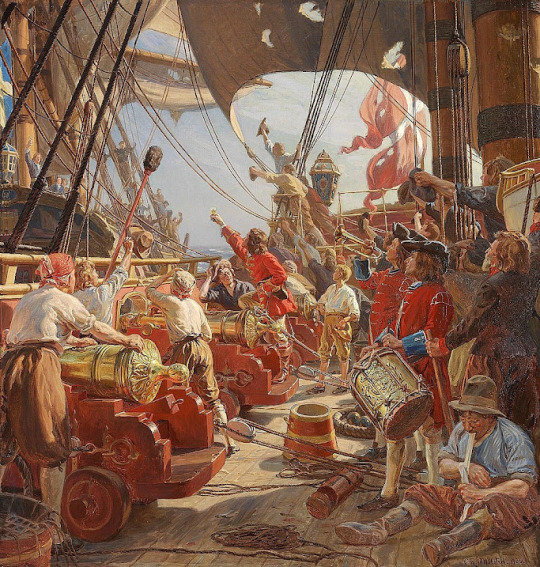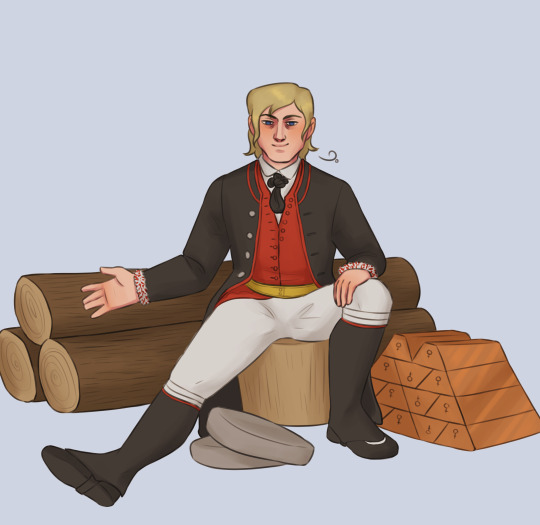#peter wessel tordenskjold
Explore tagged Tumblr posts
Text
I keep seeing this pop up, and want to clear some things:

First of all YEP it's true, apart from the nationality of the English captain, who was in fact sailing under Swedish command. The Norwegian officer was Peter Wessel Tordenskjold (his noble last name translates as Thundershield, which I love), and he is buried in the church I work at in Denmark. Why? Because he, and the rest of Norway, was part of the twin kingdoms of Denmark-Norway at the time. We were at war with Sweden, as per usual, and his gesture was actually considered so rude that he was court-marshalled for it, not for the first or indeed last time.
However, the rest of the navy, and King Frederik the 4th, loved him so dang much that they cleared him of all wrongdoings, as they always had.
Unable to cope with there being peace after 1720, Thundershield died in an illegal duel after pissing off a Swedish count in that same winter. It is speculated by many historians (including myself), that it may have been a sham duel, as the stab wound described suggests he was already dead and lying down at the time. The most common alternative suggestion is that he drank himself to death on a journey to Altona, present day Hamburg.
#the archive hobgoblin#the admiral's homebrew#the admiral's admirals#peter wessel tordenskjold#thundershield#age of sail#denmark vs sweden FITE
53 notes
·
View notes
Text

Danish Admiral Peter Tordenskjold toasts his enemies, by 19th century artist Christian Mølsted (1862-1930). Date 1925
“On guns and cups”, depicting the episode 27th july 1714 where the Danish frigate Lövendals Galley commanded by Danish-Norwegian officer Tordenskjold encounters the Swedish-owned, former English frigate De Olbing Galley on the Swedish westcoast. After a long fight the Danish ship runs out of gunpowder, and the ships part after a toast between the two opponents.
Peter Jansen Wessel Tordenskiold on 12 November 1720, at the age of 30, he was killed in a duel by Livonian colonel Jakob Axel Staël von Holstein. Tordenskiold was in the hands of the rapier , while von Holstein was armed with a heavy broadsword (belonging to the type “Karolinerverge”, “Karolinska sword”).
Daily Time Waster
2 notes
·
View notes
Text
#aFactADay2021
#185: in 1714, in the Great Northern war, a Danish ship ran out of ammunition and sent a ship over to the enemy asking for some cannonballs 14 hours into a battle so they could continue the fight. the captains ended up drinking together so no one actually died. the captain of the Danish ship, Peter Jansen Wessel "Tordenskjold" (thunder shield), saw the Swedish ship thinking it was a British ship because the Swedes had sent it over to Britain to be fitted with all these guns. he had disguised his own ship as a Dutch ship but it was a lot smaller, so when he got home his admiral or whatever it is reprimanded him for initiating battle and took him to court. he found an obscure bit of naval law that not only got him off but got him promoted!
so from the outside it looked like a Dutch and a British ship when it was actually a Swedish and a Danish-Norwegian ship!
0 notes
Note
historical dennor? 🥺
This is probably as "shippy" as I'll ever get with this one 😅 hope you still like it 🥰
During the Great Nordic War, there was a great deal of naval battles being fought between Denmark-Norway and Sweden. I don't have any statistics on how many Danes vs Norwegians contributed in these battles, but some of the big naval war heros were Norwegian. The most famous is Peter Wessel, who just went by "Tordenskjold" (Thundershield). He was from Trondheim, Norway, 14th son of a merchant, and began his career as a cabin boy on a Danish Ship. He eventually rose in the ranks and became Captain lieutenant on a battleship. He is said to have been a tactical genius, time after time outsmarting the Swedish navy and winning battle after battle. He was eventually killed with sword in a duel one year before the Great Nordic War ended.
He is supposedly very well liked in Denmark, and they buried him in Copenhagen without a seremony, instead of sending his body back to his family. Five years after losing Norway in 1814, Denmark had made a sarcophagus with a bust of him, and gave him a new place in the great chapell.
Norway is very well known for being great with sailing and anything to do with the sea in general, something that Denmark greatly admired and appreciated. Especially when it meant beating Sweden 😉

#hetalia#historical hetalia#aph denmark#aph norway#hws norway#hws denmark#dennor#i guess....#there are very few ships I will not draw and dennor is very borderland there#I like their dynamic but I can't ever see them in a romantic setting#sorry bout that 😅#not my intention to rant about this in the tags but I rarely voice my dislike of this ship#and I felt like my interpretation of the ask needed more explaination#hope you still liked the historical and vauge dennor here 😅#and thanks for the ask 🙏🙏🥰
74 notes
·
View notes
Text

Peter Tordenskjold
In 1714, Wessel was court-martialled after an indecisive sea battle with a Swedish frigate. The account of the incident is verified by the legal proceedings from November 1714. On 26 July 1714, he encountered a frigate under the English flag near Lindesnes, while flying a Dutch flag on the Løvendals Gallej himself. The other frigate was De Olbing Galley carrying 28 guns, which had been equipped in England for the Swedes and was on its way to Gothenburg under the command of an English captain named Bachmann. De Olbing Galley signalled for Løvendals Gallej to come closer, and as Wessel raised the Danish flag, Bachmann fired a broadside at him. In the English captain, Wessel met a tough match. The combat lasted all day, and when De Olbing Galley tried to escape in the evening, Wessel set more sails and continued the duel. The fight was interrupted by nightfall and renewed again indecisively the following morning. Both ships were badly damaged after around 14 hours of fighting when Wessel was running out of ammunition. He then sent an envoy to the English ship, cordially thanking the English for a good duel, and asked if he could borrow some of their ammunition in order to continue the fight. His request was denied, and the captains drank to each other's health before the ships dispersed.
https://en.wikipedia.org/wiki/Peter_Tordenskjold
1 note
·
View note
Note
Could you enlighten me about the 18th century Norway? I have such a hard time finding meaningful information about that period (or maybe it's just my lack of skills), when it comes to culture/politics. I would be so thankful, your posts are a blessing.
Thank you so much! 🥰 And apologies in advance for the essay that follows 🙏
Reading up on Norway during the 1700s, I agree with you that it’s not easy to find stuff 😓At least not in the middle of the century. But after some digging around, I think I’ve got a good grasp on it, and I’ll do the entire century, so I’ll try to be brief on each topic. To start off, the most important political event for the Nordics in this century:
Den store Nordiske Krig or Great Northern War, which lasted from 1700 to 1721. Sweden was getting too powerful of a nation in Northern Europe, something that prompted Denmark-Norway and Russia to start a war, claiming/reclaiming some territories etc. Norwegians were of course a big part of the Danish-Norwegian army, and it’s during this war we see the rise of the Norwegian war hero Peter Wessel Tordenskjold (Thunder shield), whose expertise in naval warfare rendered the Swedish useless at sea, winning battle after battle. After Sweden lost territories east of the Baltic Sea, they tried to invade Norway twice, fist in 1716, and then again in 1718 – proving catastrophic as their King was shot, and about 3 000 Swedes and Finns froze to death during a retreat over the Tydal-mountains.
The War was not great on Norway though, with being raided by the Swedish army, increase in taxes as well as surprise taxes, supplying their own army and more and more young men being drafted to fight. I think around this time Norway was one of the most militarized countries in Europe, and the number of young men dying resulted in a high number of widows and unmarried women and lack of labour force.
However, from the 1720s, the Denmark-Norway made the decision to stay out of the continental wars – something that made a huge difference in Norway’s conditions. Norway had a lot of natural resources to offer the other nations, and Norway expanded a lot of cobber mines (especially around Røros), did log driving, and produced iron – something they exported to the rest of Europe so they could have their wars. This all resulted in Norway becoming more organized and individual people acquiring more wealth and becoming more patriotic with a wish for a bank of their own and university, looking on distain at the centralization around Copenhagen in Denmark.
During the 1700s Denmark-Norway also took part in the Atlantic slave trade and had established trading fortresses in cooperation with local rulers in Ghana. Weapons, gunpowder, and alcohol were traded against ivory, gold, and slaves, which were brought to the plantations on the Virgin Islands for cotton, sugar, and tobacco. Towards the end of the 1700s people grew displeased with this though – having the slave trade abolished in 1792 as the first country in Europe to do so.
To finish off the century we have Tyttebærkrigen (1788-1790), The Lingonberry War, where Norwegian forces were ordered to attack Sweden as a distraction from battles with Russia, but it was a failure as they had bad uniforms, little food, bad weather, and no success in getting resources from the locals. About a third of them died due to sickness because of the bad conditions.
I think that sums up the 1700s all right? Norway saw a rise in wealth, larger export of natural resources, and made a lot of money on shipping and seafarers, and growing more and more unhappy about the way things were ruled from Denmark - which again ulitmately leads up to the independence in 1814.

#historical hetalia#hetalia#aph norway#hws norway#thank you for the ask!! I love your drawings as well#and just a sidenote: his outfit is from early 1800s#this is because most of the clothing references I found were that of a very upperclass#and I wanted something closer to the local big farmer instead#and based on the reference I thought this outfit had many similarities with the general clothing style in the 1700s#and I don't imagine the small farmers' fashion changing that much during that time :P#this got way lengthier than I thought it would....#summing up a century is not easy
51 notes
·
View notes